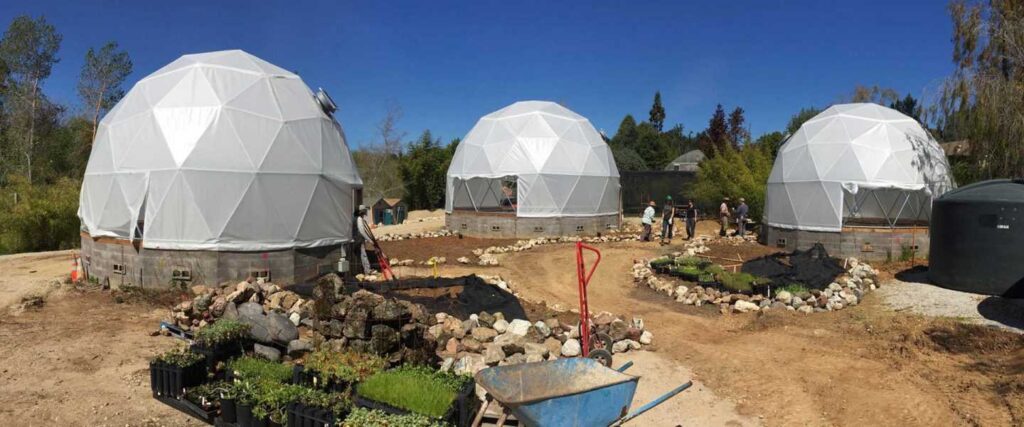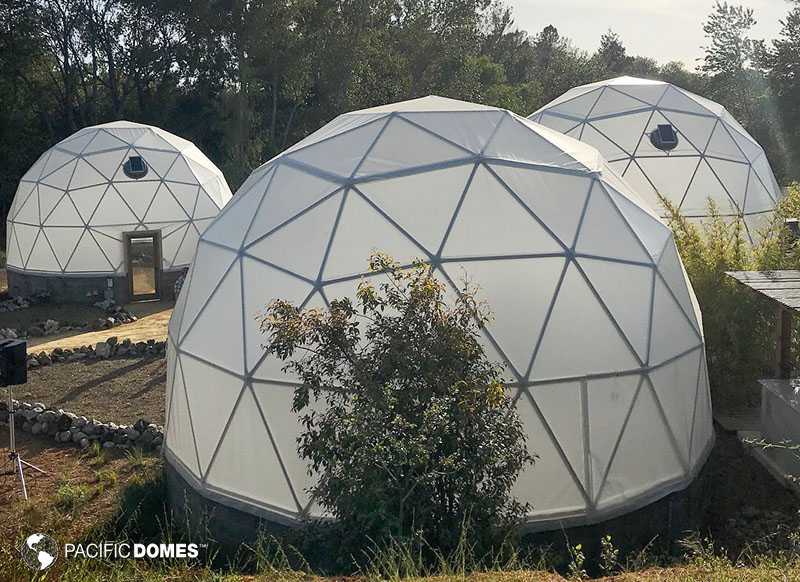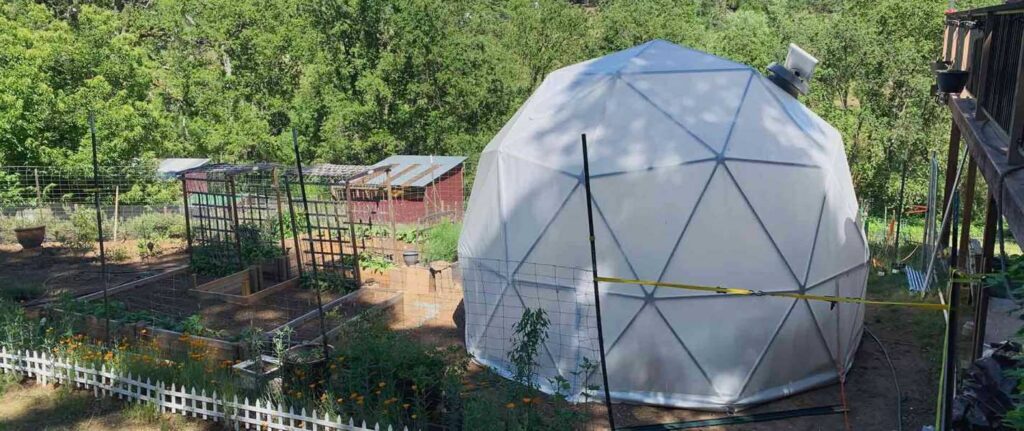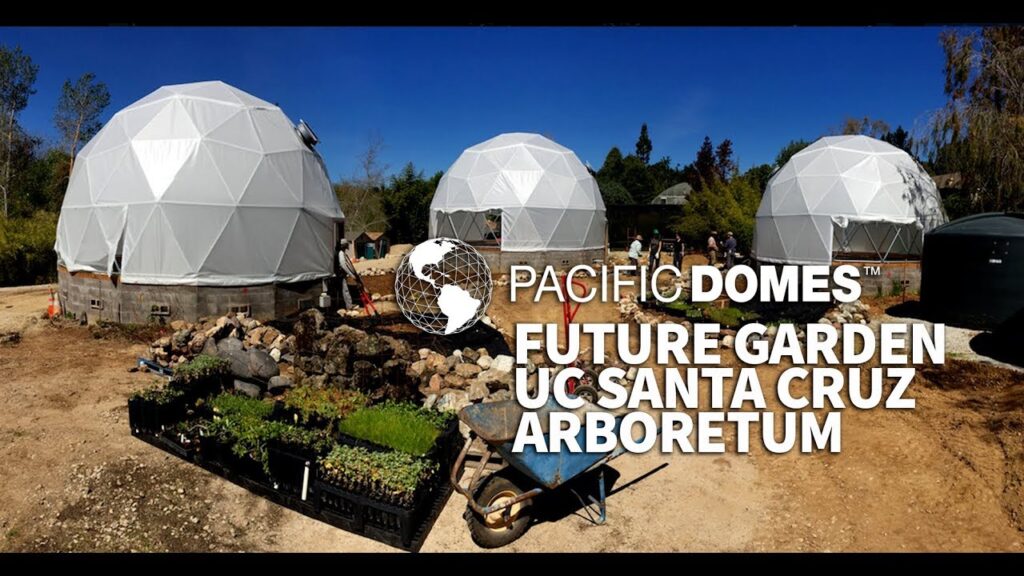
Imagine stepping into a world where plants thrive year-round, regardless of the weather outside. Picture a sanctuary filled with lush greenery, vibrant flowers, and bountiful fruits and vegetables. This is the future of gardening, made possible by the innovation of greenhouse domes. These revolutionary structures harness the power of natural light, creating the perfect environment for plants to grow in any season. From urban dwellers with limited outdoor space to seasoned gardeners looking for increased yield, greenhouse domes are transforming the way we nurture our green spaces. Discover the countless benefits and endless possibilities that await you in the captivating realm of greenhouse gardening.
Benefits of Greenhouse Domes
Increased Crop Production
One of the primary benefits of greenhouse domes is the ability to significantly increase crop production. The controlled environment within the dome allows for optimal conditions for plant growth, including temperature, humidity, and lighting. With the ability to manipulate these factors, crops can thrive and produce higher yields compared to traditional outdoor farming methods. This increased productivity is especially beneficial for commercial farmers who rely on large-scale crop production.
Extended Growing Season
Greenhouse domes provide the opportunity to extend the growing season and produce crops year-round, regardless of the external climate. By providing a protected environment, greenhouse domes can shield crops from harsh weather conditions such as frost, excessive heat, or heavy rain. This ensures a more consistent and reliable supply of fresh produce throughout the year, reducing the dependence on seasonal availability.
Protection from Extreme Weather
Extreme weather events, such as hurricanes, hailstorms, or droughts, can devastate traditional outdoor crops. However, greenhouse domes offer a level of protection against these circumstances. The sturdy construction of the dome provides a barrier that shields the plants from strong winds, hail, and other destructive weather conditions. Additionally, the controlled environment within the dome allows for the regulation of temperature and moisture levels, mitigating the impact of extreme weather on plant growth.
Pest and Disease Control
One of the major challenges in agriculture is managing pests and diseases that can damage or destroy crops. greenhouse domes provide an effective solution to this problem by creating a physical barrier between the plants and the external environment. This reduces the risk of pests, such as insects and rodents, accessing the crops. Furthermore, the controlled environment within the dome enables the implementation of pest control measures, such as introducing beneficial insects or using organic pesticides, without affecting the surrounding ecosystem.
Types of Greenhouse Domes
Geodesic Domes
Geodesic domes are known for their unique structure, composed of interlocking triangles that distribute weight evenly throughout the frame. This design provides excellent structural stability, making geodesic domes resistant to strong winds, snow, and other extreme weather conditions. Geodesic domes are also known for their optimal energy efficiency and ability to maximize sunlight exposure due to their spherical shape. These features make geodesic domes a popular choice for those looking for a durable and efficient greenhouse dome.
Polyethylene Domes
Polyethylene domes, also known as plastic domes or high tunnel structures, are constructed using a lightweight and cost-effective material called polyethylene. These domes are easy to assemble and disassemble, making them a convenient option for temporary or seasonal applications. Polyethylene domes provide protection from the elements and are typically used for smaller-scale gardening or as an entry point for novice gardeners. While they may not offer the same level of durability as other dome types, polyethylene domes are an accessible and affordable option for individuals looking to experiment with greenhouse gardening.
Glass Domes
Glass domes provide an aesthetically pleasing and highly transparent option for greenhouse domes. The use of glass allows for maximum sunlight penetration, creating optimal lighting conditions for plant growth. Glass domes are often used in commercial settings or for those with a larger budget, as they are typically more expensive to construct. However, the investment in a glass dome can result in a visually stunning and efficient greenhouse that enhances the overall gardening experience.
Plastic Film Domes
Plastic film domes, also known as hoop houses, consist of a structural framework covered by a layer of plastic film. These domes are cost-effective and easy to construct, making them a popular choice for small-scale gardening or for those on a limited budget. Plastic film domes provide protection from the elements and allow for sunlight penetration, creating a favorable environment for plant growth. While they may not offer the same level of durability as other dome types, plastic film domes are an accessible option for individuals looking to start their greenhouse journey.

This image is property of pacificdomes.com.
Design and Construction
Materials
When it comes to greenhouse dome construction, there are various materials to consider. The choice of materials depends on factors such as budget, desired aesthetics, and intended use. Common materials for greenhouse dome frames include steel, aluminum, wood, or PVC pipes. Each material has its own advantages and considerations in terms of strength, durability, and cost. The choice of the covering material, such as glass, polycarbonate panels, or plastic film, also plays a crucial role in determining the light transmission, insulation, and longevity of the greenhouse dome.
Size and Shape
The size and shape of a greenhouse dome are important considerations that depend on the available space, intended use, and environmental factors. A larger dome allows for more growing area and flexibility in crop selection, but it may require more resources for construction and maintenance. The shape of the dome can vary from spherical geodesic domes to hoop houses with a curved shape. Each shape has its own aesthetic appeal and practical considerations in terms of structural stability, ventilation, and energy efficiency.
Ventilation and Temperature Control
Proper ventilation and temperature control are critical for maintaining a healthy growing environment within a greenhouse dome. Ventilation systems, such as vents or exhaust fans, are essential for regulating air circulation and preventing the buildup of excess heat or humidity. Temperature control can be achieved through various methods, such as natural ventilation, evaporative cooling systems, or even automated climate control systems. The design and placement of vents, shades, or louvers are important factors to consider in order to optimize airflow and temperature regulation within the dome.
Structural Support
Ensuring adequate structural support is crucial to the longevity and durability of a greenhouse dome. The frame should be able to withstand the weight of the covering material, as well as any external forces such as wind, snowfall, or heavy rainfall. Geodesic domes, with their interlocking triangle framework, offer excellent structural stability. However, regardless of the dome type, it is important to consider factors such as proper anchoring, bracing, and reinforcement to ensure the structural integrity of the dome.
Greenhouse Dome Technology
Automated Irrigation Systems
Automated irrigation systems offer convenience and efficiency in greenhouse dome gardening. These systems can be programmed to deliver water at specific intervals, ensuring the plants receive the necessary moisture without the risk of overwatering or underwatering. Some advanced irrigation systems can also monitor soil moisture levels and adjust watering accordingly, optimizing water usage and preventing water waste. Automated irrigation not only saves time and effort for the gardener but also helps promote healthier plant growth.
Climate Control Systems
Maintaining optimal climate conditions within a greenhouse dome is essential for crop growth. Climate control systems provide the ability to regulate factors such as temperature, humidity, and CO2 levels. These systems can include heaters, evaporative coolers, dehumidifiers, and carbon dioxide generators. By closely monitoring and adjusting these parameters, greenhouse dome owners can create an ideal environment for their crops, ensuring optimal growth and productivity throughout the year.
Solar Panels and Renewable Energy
Incorporating solar panels into greenhouse dome design can greatly reduce energy costs and promote sustainability. Solar panels harness the sun’s energy to generate electricity, which can be used to power various systems within the dome, such as lighting, ventilation, or climate control. By utilizing renewable energy sources, greenhouse dome owners can reduce their reliance on traditional power sources and minimize their carbon footprint. Additionally, advances in solar technology have made it more efficient and cost-effective, making it a viable option for greenhouse dome owners.
Smart Monitoring and Management
Smart monitoring and management systems utilize sensors, cameras, and data analysis to provide real-time information about the greenhouse dome’s environment. These systems can monitor factors such as temperature, humidity, soil moisture, and plant health. By collecting and analyzing this data, greenhouse dome owners can make informed decisions regarding irrigation, climate control, and pest management. Smart systems can also provide alerts or suggestions for adjustments, helping optimize crop growth and minimize resource waste.

This image is property of pacificdomes.com.
Cost Considerations
Initial Investment
The initial investment in a greenhouse dome can vary depending on several factors, such as size, materials, and technology. Geodesic domes and glass domes typically come with a higher upfront cost due to their durable construction and higher-quality materials. On the other hand, plastic film domes and polyethylene domes are more affordable options for those on a tight budget. Additionally, incorporating advanced technology such as automated irrigation systems or climate control systems can increase the initial investment but may result in long-term savings.
Operating Costs
Operating costs for greenhouse domes include ongoing expenses such as heating, cooling, lighting, and irrigation. The energy consumption of these systems can significantly impact the overall operating costs. However, advancements in energy-efficient technology, such as LED lighting and solar panels, can help reduce energy costs. Additionally, the choice of crops and the frequency of planting can affect the ongoing expenses associated with maintaining the greenhouse dome. It is important to carefully consider these factors when budgeting for operating costs.
Return on Investment
The return on investment (ROI) for a greenhouse dome depends on several factors, including crop selection, market demand, and operational efficiency. Higher-yield crops or specialty crops that command a premium price can potentially yield a higher ROI. Additionally, implementing cost-saving measures such as energy-efficient technology or sustainable practices can help maximize the ROI over time. It is important to carefully assess the potential returns and weigh them against the initial investment and ongoing operating costs before deciding to invest in a greenhouse dome.
Environmental Impact
Reduced Water Usage
Greenhouse domes allow for more efficient water usage compared to traditional outdoor farming methods. With the ability to control watering systems and monitor soil moisture levels, greenhouse dome owners can optimize watering schedules and reduce water waste. Additionally, implementing techniques such as drip irrigation or hydroponics can further minimize water usage by delivering water directly to the plants’ roots. By reducing water consumption, greenhouse domes contribute to water conservation efforts and help alleviate the strain on water resources.
Energy Efficiency
Greenhouse domes offer the opportunity to incorporate energy-efficient technologies, reduce reliance on traditional power sources, and minimize energy consumption. Utilizing natural sunlight through ample windows or transparent coverings reduces the need for artificial lighting during the day. Additionally, the integration of energy-efficient systems such as LED lighting or automated climate control can significantly reduce energy usage. By prioritizing energy efficiency, greenhouse dome owners can contribute to reducing greenhouse gas emissions and promote a more sustainable future.
Sustainable Practices
Greenhouse domes provide a platform for implementing sustainable practices in agriculture. The controlled environment within the dome allows for the use of organic farming methods, reducing the need for synthetic pesticides and fertilizers. Implementing composting systems or utilizing organic waste as a nutrient source can further enhance the sustainability of greenhouse dome gardening. By prioritizing sustainable practices, greenhouse dome owners can contribute to protecting ecosystems, conserving resources, and promoting healthier food production methods.
Carbon Footprint
Greenhouse domes have the potential to reduce carbon emissions associated with traditional farming practices. By incorporating renewable energy sources such as solar panels and implementing energy-efficient systems, greenhouse dome owners can minimize their reliance on fossil fuels. Additionally, the ability to produce crops closer to urban centers reduces the need for long-distance transportation, further reducing carbon emissions from the transportation sector. By reducing carbon footprints, greenhouse domes play a role in mitigating climate change and creating a more environmentally friendly food production system.

This image is property of pacificdomes.com.
Greenhouse Dome Applications
Commercial Farming
Greenhouse domes have significant applications in commercial farming. The ability to control environmental factors allows for year-round crop production, which is highly beneficial for meeting the demands of the market. Greenhouse domes also provide a platform for cultivating specialty crops that require precise growing conditions, enabling farmers to tap into niche markets and potentially achieve higher profit margins. Additionally, the protection from extreme weather events and the ability to implement efficient irrigation and pest control systems contribute to increased productivity and profitability in commercial farming.
Urban Gardening
Greenhouse domes offer a solution to the space constraints often faced by urban gardeners. By utilizing vertical growing techniques and compact designs, greenhouse domes can be installed in small urban spaces such as rooftops or balconies. This allows urban gardeners to grow a wide variety of crops, including herbs, vegetables, or even flowers, regardless of the limited space. Urban gardening with greenhouse domes enhances food security, promotes self-sufficiency, and encourages a closer connection between city dwellers and their food sources.
Community Gardens
Greenhouse domes can be utilized in community garden initiatives to provide a controlled and productive gardening environment for community members. These initiatives enable individuals in the community to come together and actively participate in the cultivation of fruits, vegetables, or ornamental plants. Greenhouse domes offer a communal space where people can share knowledge, collaborate on gardening projects, and enjoy the benefits of fresh produce. Community gardens with greenhouse domes foster a sense of community, promote sustainable practices, and improve access to healthy food.
Research and Education
Greenhouse domes serve as valuable tools for research and education in the field of agriculture. Academic institutions, research centers, and botanical gardens utilize greenhouse domes to conduct experiments and study plant growth under controlled conditions. The ability to manipulate environmental factors allows researchers to investigate various aspects of plant physiology, genetics, or crop management. Additionally, greenhouse domes provide an educational platform where students can gain hands-on experience and learn about sustainable gardening practices. This promotes continuous innovation in agricultural science and ensures the transfer of knowledge to future generations.
Challenges and Limitations
Maintenance and Repairs
Greenhouse domes require regular maintenance and occasional repairs to ensure their longevity and functionality. The covering material may deteriorate over time and need replacement, especially in extreme weather conditions. Routine maintenance tasks such as cleaning, checking for leaks, and inspecting the structural integrity are crucial in preventing potential issues. Additionally, repairs may be necessary in case of damage from storms or accidents. It is important to factor in the time and costs associated with maintenance and repairs when considering the investment in a greenhouse dome.
Space Constraints
The size and shape of a greenhouse dome depend on the available space, which may be limited in certain locations. Urban environments or properties with small yards may pose challenges in finding suitable space for a greenhouse dome. It is important to carefully assess the available area and consider size options that maximize the growing space without compromising functionality or violating local regulations. Additionally, space constraints may also limit the selection of crops or the capacity for expansion in the future.
Lack of Natural Pollinators
While greenhouse domes provide a protected growing environment, they may lack natural pollinators such as bees or butterflies. In traditional outdoor farming, these pollinators play a crucial role in fertilizing flowers and ensuring fruit set. However, in a greenhouse dome, artificial pollination methods may be necessary to ensure the successful development of fruits and seeds. Hand pollination or the use of specialized tools can help overcome this limitation and ensure proper pollination within the dome.
Technical Expertise
Successful management of a greenhouse dome requires a certain level of technical expertise. Understanding the principles of plant growth, greenhouse management, and pest control is essential for maximizing the potential of the dome. Additionally, implementing advanced technologies such as automated systems or climate control requires knowledge and skills in their operation and maintenance. It is important to acquire the necessary expertise or seek professional guidance to ensure the proper management of a greenhouse dome.

This image is property of i.ytimg.com.
Future Innovations
Advanced Climate Modeling
Advancements in climate modeling and data analysis have the potential to revolutionize greenhouse dome gardening. By incorporating real-time weather data and predictive models, greenhouse dome owners can optimize their crop selection, planting schedules, and climate control strategies. Advanced climate modeling can provide accurate insights into the future conditions within the dome, allowing for proactive adjustments and improved decision-making. This technology holds the promise of increasing productivity, reducing resource waste, and adapting to changing climate patterns.
Vertical Farming Integration
The integration of vertical farming techniques with greenhouse domes represents a future innovation in agriculture. Vertical farming utilizes stacked layers of crops, often utilizing artificial lighting and hydroponics or aeroponics systems. By combining the controlled environment of a greenhouse dome with vertical farming, growers can maximize the use of space and significantly increase crop yields. This integration allows for the cultivation of a larger variety of crops and offers a more efficient and sustainable approach to food production in limited spaces.
Robotics and AI
The integration of robotics and artificial intelligence (AI) into greenhouse dome gardening holds the potential for increased efficiency, precision, and productivity. Robotic systems can assist in tasks such as planting, harvesting, or monitoring plant health, reducing labor requirements and improving overall efficiency. AI algorithms can analyze data collected from sensors and cameras to provide insights and suggestions for optimizing crop growth and resource usage. The combination of robotics and AI in greenhouse dome technology offers a glimpse into a future where automation and data-driven decision-making shape the agriculture industry.
Biotechnology
Advances in biotechnology, such as genetic engineering or plant tissue culture, can transform the capabilities of greenhouse dome gardening. By introducing traits such as disease resistance or enhanced nutrient uptake into crops, biotechnology can significantly improve crop productivity and quality. Additionally, plant tissue culture techniques enable the rapid production of genetically identical plantlets, allowing for faster propagation and increased planting options. Biotechnology has the potential to revolutionize greenhouse dome gardening by providing crops tailored to specific growing conditions and consumer demands.
Conclusion
Greenhouse domes offer a wide range of benefits and applications in the field of gardening and agriculture. From increased crop production and extended growing seasons to protection from extreme weather and improved pest control, greenhouse domes provide solutions to many challenges faced by traditional farming methods. The various types of greenhouse domes, including geodesic domes, polyethylene domes, glass domes, and plastic film domes, allow for flexibility in design and construction to suit different needs and budgets.
The integration of technology, such as automated irrigation systems, climate control systems, solar panels, and smart monitoring, enhances the efficiency and productivity of greenhouse dome gardening. While there are initial investments and ongoing operational costs to consider, greenhouse domes can yield substantial returns on investment while promoting sustainability and reducing environmental impact.
Greenhouse domes find applications in commercial farming, urban gardening, community gardens, research, and education, offering opportunities for increased food production, community engagement, and scientific advancement. However, challenges related to maintenance and repairs, space constraints, lack of natural pollinators, and the need for technical expertise exist and should be considered when embarking on greenhouse dome gardening.
Looking to the future, advancements in climate modeling, vertical farming integration, robotics and AI, and biotechnology hold promise for further improving the capabilities and sustainability of greenhouse dome gardening. As the world faces increasing food demand and environmental challenges, greenhouse domes represent a viable and innovative solution for the future of gardening and sustainable agriculture.

This image is property of b1387267.smushcdn.com.

